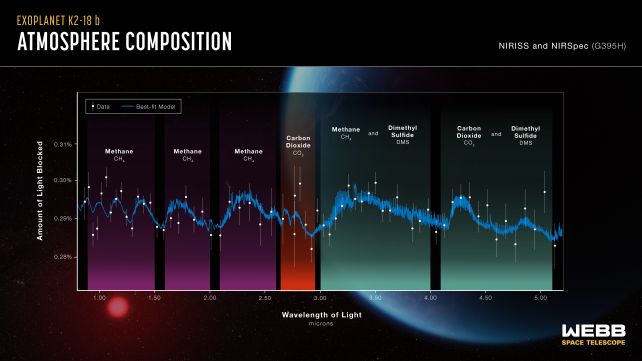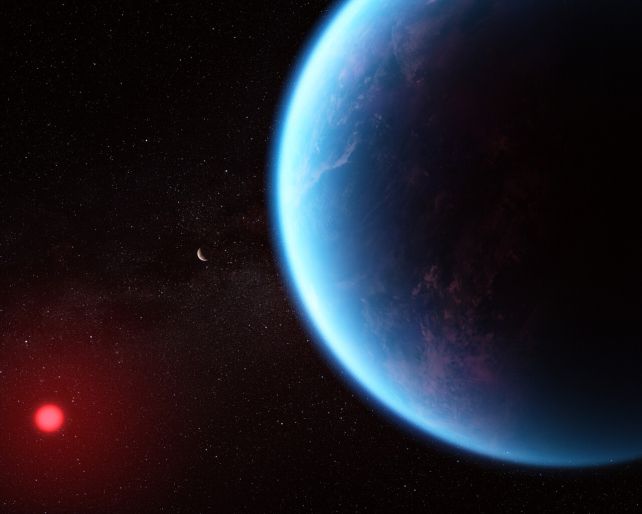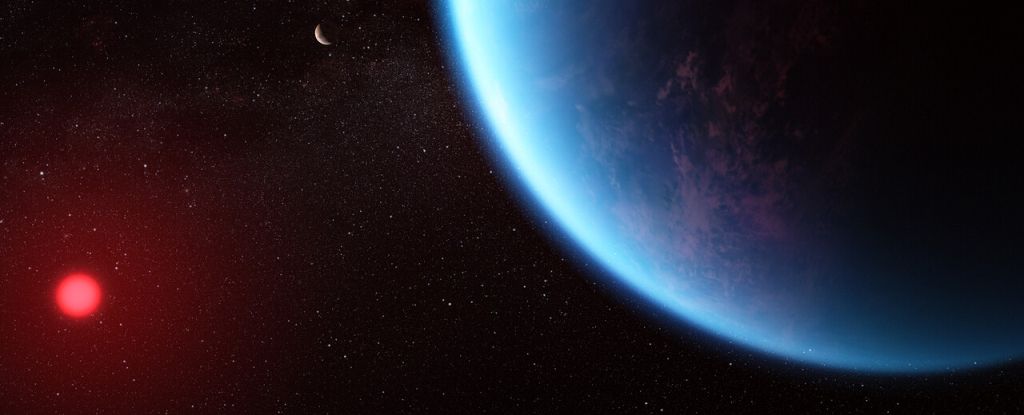A potential water world orbiting a dim red star a mere 120 light-years away has just become a little bit more exciting.
A probe into the atmosphere of K2-18b reveals the presence of carbon dioxide and methane, as scientists previously predicted for an ocean planet with a hydrogen-rich atmosphere, or Hycean world.
Moreover, the observations reveal a tantalizing hint of dimethyl sulfide – a signature of biology that scientists predict might be detected on Hycean worlds. Here on Earth, dimethyl sulfide is only produced by life; and the majority of it is from marine phytoplankton.
“Our findings underscore the importance of considering diverse habitable environments in the search for life elsewhere,” says astronomer Nikku Madhusudhan of the University of Cambridge.
“Traditionally, the search for life on exoplanets has focused primarily on smaller rocky planets, but the larger Hycean worlds are significantly more conducive to atmospheric observations.”
Astronomers have had their eye on K2-18b for some time.
In 2019, it was the first habitable zone rocky world (as opposed to gaseous, like Jupiter and Saturn) in whose atmosphere water was detected. The habitable zone is the distance from its host star at which liquid water can persist on the surface – not so far as to freeze into ice, nor so far that it steams away.
K2-18b is very different from Earth. It’s significantly heftier, coming in at around 8.6 Earth masses and 2.6 Earth radii; and it orbits a red dwarf star pretty closely, once every 33 days.
However, red dwarf stars are cooler and dimmer than the Sun, which means K2-18b receives similar stellar irradiation to Earth. It’s like Baby Bear’s porridge – just right.
Madhusudhan and his colleagues assessed K2-18b in 2020, and found that habitability is possible. They also identified K2-18b as a potential Hycean world in 2021.
“Some of the conditions in the oceans of these worlds could be similar to habitable conditions in Earth’s oceans, i.e. similar temperatures and pressures, presence of liquid water and energy from the star,” Madhusudhan told ScienceAlert at the time.
“There are many open questions but this is only a first guess at this stage. The assumption is that if microbial aquatic life can form in these oceans in the same manner as they did on Earth then some of the biosignatures may also be common.”

But the researchers needed more data. They needed the James Webb Space Telescope, to peer more closely into the exoplanet’s atmosphere, to look for signs. And they finally got it.
Using JWST’s near-infrared NIRSpec and NIRISS instruments, they watched K2-18b as it orbited between us and its host star, twice. Then, they studied the difference in the star’s light, the result of having traveled through, and being changed by the composition of, the exoplanet’s atmosphere.
When they teased apart these changes, the researchers found evidence of carbon molecules, carbon dioxide, and methane. The spectrum of light also revealed hints – but only hints – of dimethyl sulfide.
This means that the observations are not sufficient to determine whether K2-18b is habitable. But we’re tantalizingly close.
“Upcoming Webb observations should be able to confirm if dimethyl sulfide is indeed present in the atmosphere of K2-18 b at significant levels,” Madhusudhan says.

The next step will be to turn JWST’s mid-infrared MIRI to the exoplanet, to investigate the possibility of dimethyl sulfide in greater detail, and look for other possible biosignatures in the exoplanet’s atmosphere.
In a broader context, the results demonstrate that JWST is capable of detecting biosignatures in exoplanet atmospheres, an important first step towards finding life on another planet.
“Our ultimate goal is the identification of life on a habitable exoplanet, which would transform our understanding of our place in the Universe,” Madhusudhan says.
“Our findings are a promising step towards a deeper understanding of Hycean worlds in this quest.”
The research has been accepted into The Astrophysical Journal Letters, and can be read here.





